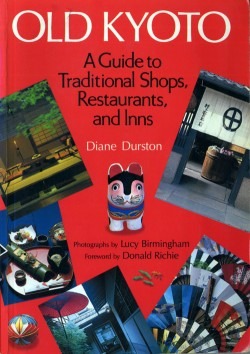
Old Kyoto:A Guide to Traditional Shops, Restaurants, and Inns By Diane Durston, Photographs by Lucy Birmingham, Forward by Donald Richie, Reprinted edition 2005, Kodansha, Paperback, 244pp
[F]or the traveler who wants to savor the hidden charm and beauty of this ancient city’s backstreets at a leisurely pace, Diane Durston’s updated and fully revised edition of her 1986 book, Old Kyoto, offers a warm and personable guide.
Over centuries, the traditional arts and their associated crafts evolved to a highly refined degree in Kyoto. Sadly many of the family-run businesses, passed down through generations, are now disappearing. However, some survive behind the discreet facades of machiya (traditional wooden townhouses), with their understated signage in Japanese and noren curtains, sandwiched between the ever- increasing concrete of modern buildings.
Durston lived in Kyoto for 18 years and grew to know these businesses and their owners intimately. Her special talent is to engage with the reader as if we were old friends she is taking to her favorite haunts. As we wander from shop to shop, each detail she draws our attention to leads to more; tracing the historical development, retelling an anecdote about a famous customer, relating stories from the community and all this while she explains the techniques involved. Her discussion touches on art, history, architecture, Buddhism, cuisine, local beliefs and even gossip. Yet we never feel as if she is trying to impress us, but rather we are invited to share her enthusiasm.
In a sweet bean cake shop she explains how a particular confectionary was named after the era of the great feudal lord Toyotomi Hideyoshi; later she describes how a family continues to makes tofu over wood-burning stoves, a backbreaking labor of love, in an age when most housewives opt for the mass- produced variety at the supermarket. She offers glimpses behind the scenes, like how tealeaves are used to polish the wooden floors of a restaurant to a deep sheen or why the lack of materials is causing bamboo craft to decline. Durston’s wealth of knowledge infuses her overview of the cultural factors that created these crafts, the way they inter- relate and the actual processes.
Aside from the abundance of craft shops covered, the selection of restaurants and ryokan is excellent, with a range to suit any budget. From the pinnacle of Kyoto’s kaiseki cuisine to local izakaya, from tiptoeing through the hallowed rooms of the most luxurious ryokan and marveling at valuable antiques, Durston also throws open the doors of the more casual local inns, making this book worth consulting before traveling.
Visitors can create their own walking tours with ease since the book divides the city into sections with clear maps and each entry includes the kanji (Chinese characters) to aid exploration.
Visitors can create their own walking tours with ease since the book divides the city into sections with clear maps and each entry includes the kanji (Chinese characters) to aid exploration.
It is gratifying to note that almost all of the businesses still continue since she first wrote this book almost 20 years ago but clearly their future is uncertain. Recently, although there is a trend towards renovating machiya for business purposes, there doesn’t seem to be much of a revival of the traditional crafts. Now may be the last chance to savor the traces of a world that is being swept away by the process of modernization.



